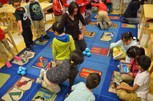We believe the roll out of computer science (CS) education should match the culture, vision, and unique character of every school and its community. This includes creating buy-in by aligning roll out plans to the needs, wants, and expectations of school leaders, teachers, students, and their families. As we know from the NYC DOE Framework for Great Schools, when these stakeholders collaborate, our students can achieve more.
Through close partnership with schools, we’ve learned teachers and school leaders understand their school communities best. We hope the stakeholder buy-in and team-building guide below provides a basic outline of how to engage your school community, but ultimately, you should decide who you need to engage to support successful implementation of CS education at your school.
- Building a Team
- Creating a Buzz
- Making a case for CS with School Leaders
- Making CS relevant for Teachers
- Involving Families & the Community
- Engaging Students
- Takeaways
Building a Team
Whether the team is started by a motivated student, parent, teacher, or a school leader, cultivating a diverse group to support the roll out of CS education is important. Team members can represent a variety of school personnel from multiple grades and departments such as technology coordinators, technology single points of contact (SPOCs), parent coordinators, grade leaders or department chairs. While any staff or community members who expresses a vested interest in implementing CS education can provide much-needed help, you might consider including those who may be critical of the roll out to make sure their voice is included in the planning.
Teams should consider the following when building a CS team:
- Make sure you include a diversity of stakeholders in your CS team.
- Identify and support teachers who might be open to integrating CS into their instructional practices. This need not only be the “techy” teacher; invite any teacher who is open to trying out new practices to join the team.
- Start with a discussion to align needs, wants, and expectations for the roll out of CS.
- Use existing school planning time or find time for your CS team to meet regularly to plan, prototype, and evaluate the roll out. Teacher team meetings can be used for members on a grade or content team to plan together and share best practices to integrate CS. Also, vertical team meetings with administration and your CS teams allow you to gather grade leaders, department heads to discuss progress with CS integration and to address any issues as they arise.
- Mentorships and teacher partnerships are another approach. Having teachers bounce ideas off each other and seek out support is a crucial element to the successful implementation of CS education. We’ve also seen schools successfully use tech-savvy students to mentor less-savvy teachers.
- Publicly recognize CS team efforts, especially for those who are taking on a role that are outside their comfort zones.
Creating a Buzz about Computing
Once your team has had some time to plan how you want to roll out CS education, you can create momentum-building opportunities that engage the whole school community. These events can create an easy entry point for people new to CS education and generate buy-in. Below are a few ideas from events NYC schools have tried:
- Schools have held launch events or rallies with motivational programming, such as speeches from leaders of industry or the community, presentations highlighting student work, or fun whole-group activities that teach basic CS concepts. Many schools have hosted school-wide “Hour of Code” events in which everyone tries out a CS lesson or activity.
- Once teachers and students have tried out CS concepts and practices, we’ve seen schools successfully host events celebrating the school’s achievements and encouraging broader participation in CS. Examples include “hackathons” in which students use their newly honed CS skills to build solutions to a set of challenges, “maker nights” in which teachers, students, and families come together to build physical computing projects, and Scratch Days in which students build games using Scratch. We’ve even seen pep rallies in which students wear their physical computing projects during dance performances.
- During the annual CS Education Week commemorating computing pioneer Admiral Grace Hopper’s December 9th birthday, many materials can be acquired to spruce up hallways and classrooms. These materials provide a daily reminder of the opportunities presented through CS education.
- Showcase and celebrate school participation in CS education using social media. You might consider using Facebook, Twitter, Edmodo, and so on to post media related to student work. There are lots of Twitter hashtags you can use to share your work with the wider CS education community, including national peers using #CSforAll or local using #CS4AllNYC
Building a Case for CS with School Leaders
“The principal sets the tone for the school, develops a climate of inclusiveness, and inspires staff and students with a clear vision for student achievement.” (Framework for Great Schools). Given this responsibility, school leaders might find CS education compelling in the following ways:
If a school leader is…
- …already seeking to build coherent instructional experiences for students, CS education can be a conduit for improving project-based or interdisciplinary work.
- …focused on teacher development through offering meaningful professional development opportunities, CS education is a way to offer new content and engaging teacher training for both novice and experienced educators.
- …building a stronger connection to college and career readiness, CS education can be used to build experiences with tech companies or higher education institutions.
If a school leader is concerned about…
- …funding streams, they can check out some of different resources for technology, programming, staff training, and recruitment such as; Resolution-A funding from City Council or Borough Presidents or DonorsChoose.org which allows teachers to propose crowd-funded projects.
- …finding training, reach out to the CS4All Team to connect with professional development that is free to NYC DOE teachers and includes per-session and relevant materials for the first year of implementation.
We know school leader buy-in is essential for long-term sustainability of CS4All. If school leaders can support a culture of CS, the initiative has the potential grow to reach all students.
Making CS relevant for Teachers
The DOE is committed to helping teachers acquire skills and expertise by providing opportunities for them to develop, grow, and learn from peers and experts—CS education is no exception. “Strong teachers innovate and hone their practice through continuous learning and frequent professional development.” (Framework for Great Schools). Based on this, teachers might find CS education relevant in the following ways:
If a teacher is…
- …looking to improve student engagement, CS education, at its best, is hands-on and student-driven; also, CS education can provide great opportunities to get students more engaged through culturally-relevant projects.
- …looking to connect with a network of like-minded educators, they can join teacher communities like the CSTA NYC Chapter or the Scratch Ed Meetup.
If a teacher is concerned about…
- …where to fit CS education into an already packed curriculum, they may check out the integrated units to see how we’ve designed ways to easily integrate CS into existing subject areas
We know teacher buy-in is critical for the implementation of CS4All. If teachers can bring new practices to their classroom, we’ll be better able to reach all NYC students with CS education.
Families and the Community
“Schools create welcoming environments for families and take advantage of community resources to enrich the civic life of the school. Schools have a commitment to build strong partnerships with business and community-based organizations that enrich the school and the entire school community” (Framework for Great Schools). Using this example, families and communities might find CS education significant (helpful) in the following ways:
If a family or community member is…
- … seeking meaningful engagement opportunities with their school, CS education is a great impetus for collaborative planning through events like Hour of Code, maker nights, or hackathons.
- … looking to bridge the gap between school and the workplace, students who have experience in CS education can take advantage of career visits or might be prepared for an internship using their CS skills in any sector.
- … exploring ways to elevate the students as citizens, CS education is a great way to connect what their learning in the classroom by creating projects that have roots in and serve challenges of the school’s community.
If a family or community member is concerned about…
- …finding ways to bridge the tech skill gap, students who have advanced skills can be leveraged to teach parents and community members.
We know family and community buy-in is critical for the implementation of CS4All as they provide essential connections to the lives of our students outside the school day.
Students
“Student-centered learning environments develop students who push and support each other, creating a collaborative and generous atmosphere in the classroom. The classroom must support the social and emotional growth of all students.” (Framework for Great Schools). Students might find CS education interesting in the following ways:
If a student wants…
- … to make an impact in their community, CS education will provide an opportunity to design and create solutions that matter to you.
- … to express themselves in an ever-growing digital world, CS education is an opportunity to learn how to participate as more than a consumer of digital media.
- … to connect with digital makers and designers, CS education builds a computational vocabulary and ability to communicate with digital creators.
- … to experience what it’s like to work in a technology career, CS education will leave them prepared with the basic skills they’ll need to get started.
If a student is concerned about…
- …making sense of the world, CS education empowers students to ask questions and understand computational things in the world.
- …how their personal interests connect with computers and technology, CS education provides an opportunity to explore those connections through engagement of computational concepts and practices.
- …pursuing science and engineering fields in college, CS education prepares students in exploring those careers before diving deeper.
We know student buy-in is critical for the implementation of CS4All. If we employ a broad range of representations and reasons to engage students we are more likely to reach students that have nascent CS identities. Similarly, if you can bring students into the planning process of your CS4All roll out, they can take an active role in promoting their ability to make a relevant impact within local communities through engagement of CS education.
Takeaways
We hope the stakeholder buy-in and team-building guide will help you engage your school community. Here are a few main points..
- Build a team that represents a diversity of stakeholders from your school community.
- Create momentum-building opportunities that engage the whole school community through events like hackathons, maker nights, or hour of code events.
- Leverage the strengths, interests, and concerns of school leaders, teachers, students, their families, and the community when making a case for your CS roll out.
Resource content by Matthew Boyle and JoAnn Westhall, with the assistance of the CS4All team. Consultation by Tythe Design and Tiny Panther. Published by CS4All.



